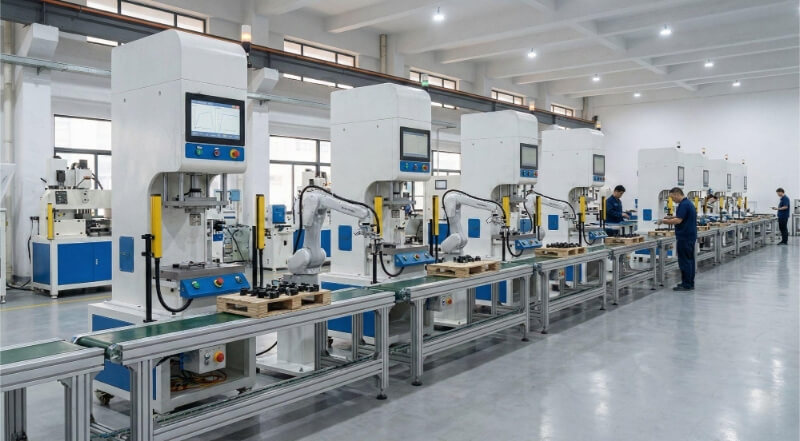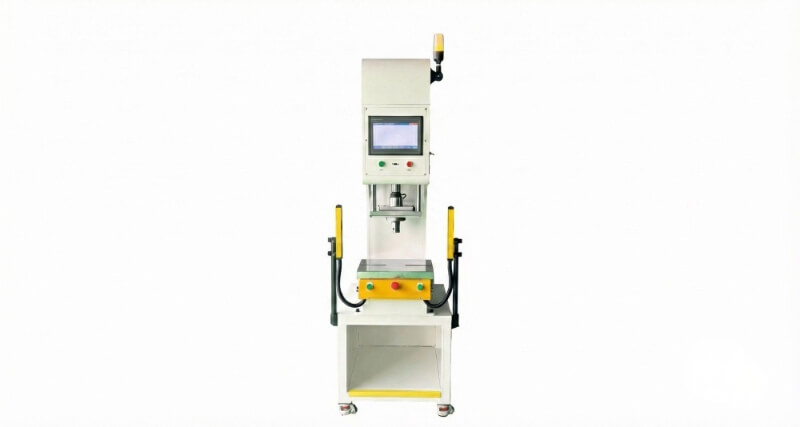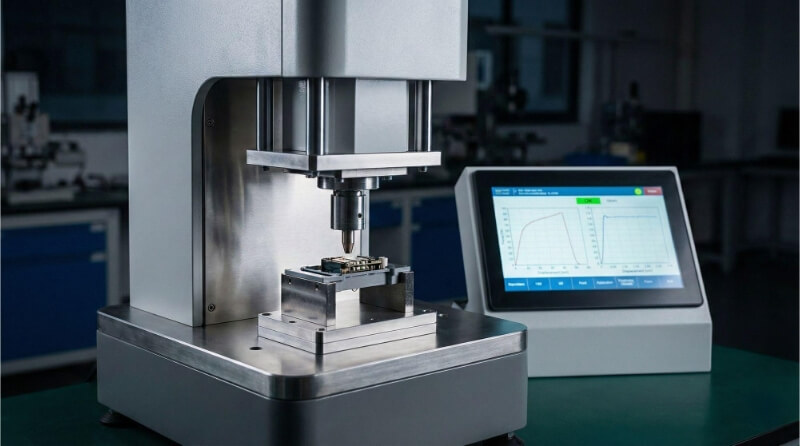Plastic products are everywhere in our daily lives. But have you ever wondered how manufacturers create complex parts with multiple materials? Many struggle to produce durable, multi-material components efficiently. This challenge often leads to increased costs and longer production times. Insert molding offers a solution to these issues.
This innovative process opens up new possibilities for product design and manufacturing efficiency. Let’s explore how insert molding works and why it might be the right choice for your next project.

Understanding Insert Molding
What is Insert Molding?
Insert molding is a cutting-edge manufacturing technique. It combines two or more materials into a single, cohesive component. The process starts with placing a pre-made insert into a mold cavity. Then, molten plastic is injected around it. As the plastic cools and solidifies, it bonds with the insert.
Key Advantages of Insert Molding in Manufacturing
Insert molding offers several benefits to manufacturers and product designers. It streamlines production by eliminating secondary assembly steps, leading to faster production times and lower labor costs.
The technique also enhances product durability. The strong bond between the plastic and the insert reduces the risk of component separation.
Insert molding allows for complex designs that would be difficult or impossible to achieve with traditional methods. It enables the creation of parts with precise tolerances and intricate geometries.
The process can significantly reduce material waste. Integrating components directly into the molded part eliminates the need for excess material used in traditional assembly methods.
Types of Insert Molding Processes
Vertical Insert Molding
Vertical insert molding uses a vertically oriented injection molding machine. The mold opens and closes along a vertical axis. This setup is ideal for inserts that need to be placed precisely.
Gravity assists in keeping the inserts in place during the molding process. This makes vertical insert molding suitable for parts with multiple inserts or complex geometries.
Horizontal Insert Molding
Horizontal insert molding employs a horizontally oriented injection molding machine. The mold opens and closes along a horizontal axis, and this configuration is commonly used in high-volume production.
Horizontal machines often have faster cycle times than vertical ones. They’re well-suited for parts with simpler insert configurations, and automated insert placement is easier to implement with horizontal machines.
Rotary Insert Molding
Rotary insert molding uses a rotating table with multiple mold stations. Each station performs a different part of the process, allowing for continuous production.
As the table rotates, inserts are loaded at one station, the plastic is injected at another, and the part is then cooled and ejected at subsequent stations.
Automated Insert Molding
Automated insert molding incorporates robotic systems for insert placement and part handling. This reduces the need for manual labor and increases production speed.
Robots can place inserts with high precision and consistency. They can also handle multiple inserts simultaneously.
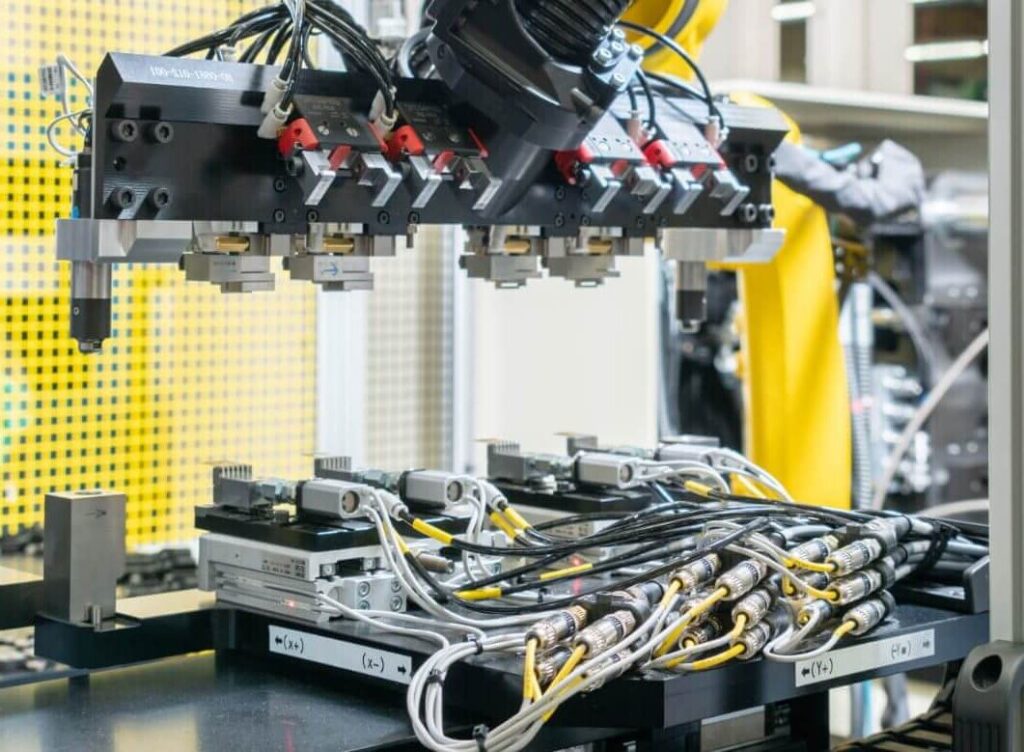
The Insert Molding Process: Step-by-Step
Insert molding follows a precise sequence of steps. Here’s a detailed breakdown of the process:
Insert preparation
- Select the appropriate insert material (metal, plastic, etc.)
- Clean the insert to remove any contaminants
- Apply any necessary coatings or treatments for better adhesion
Mold setup
- Design and fabricate a custom mold with cavities for the insert and plastic
- Install the mold in the injection molding machine
- Set the machine parameters (temperature, pressure, cycle time)
Insert placement
- Manually or automatically position the insert in the mold cavity
- Ensure proper alignment and orientation of the insert
Plastic injection
- Close the mold
- Inject molten plastic into the mold cavity around the insert
- Apply pressure to ensure complete filling of the mold
Cooling and ejection
- Allow the plastic to cool and solidify
- Open the mold
- Eject the finished part with the embedded insert
Tooling and Mold Design for Insert Molding
Factors to Consider in Mold Design
Insert molding mold design requires careful planning. The mold must accommodate both the plastic part and the insert, often leading to more complex designs than standard injection molds.
Material selection for the mold is crucial. The mold must withstand high temperatures and pressures. It also needs to resist wear from repeated insert placement and part ejection.
The gate location requires special attention in insert molding. Gates must be positioned to ensure proper plastic flow around the insert.
Cooling channel design is another critical factor. Efficient cooling ensures consistent part quality and reduces cycle times.
Importance of Precision in Insert Placement
Precise insert placement is key to successful insert molding. The mold design must include features to secure the insert in the correct position. This might involve pins, recesses, or other locating mechanisms.
Insert placement tolerances are typically very tight. Even small misalignments can lead to defects or functional issues in the final part.
The mold must also account for thermal expansion. Both the insert and the mold material expand when heated. Designers must factor this in to maintain precision throughout the molding cycle.
Multi-Cavity Mold Design for Insert Molding
Multi-cavity molds increase production efficiency in insert molding. These molds produce multiple parts in a single cycle. However, they present unique challenges in inserting molding applications.
Each cavity in a multi-cavity mold must be identical. This ensures consistent part quality across all cavities. Achieving this level of precision is more challenging when inserts are incorporated.
Insert loading becomes more complex in multi-cavity molds. Designers must consider how operators or automated systems will place inserts in all cavities efficiently.
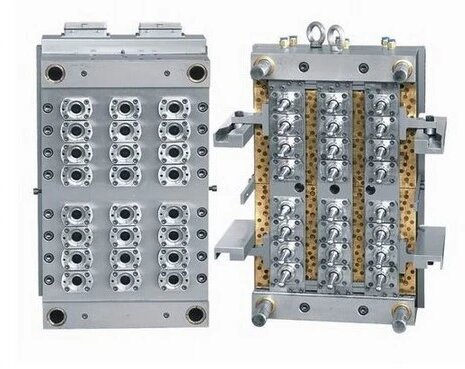
Insert Molding vs. Overmolding
Defining the Differences
Insert molding and over-molding are related processes, but they have key differences:
Insert Molding:
- Inserts are placed in the mold before injection
- Creates a single, integrated part
- Typically uses metal or hard plastic inserts
Overmolding:
- Involves molding over an existing part
- Creates a layered or multi-material component
- Often uses softer materials over harder substrates
When to Use Insert Molding vs. Overmolding
Choose Insert Molding when:
- You need to embed metal components
- Structural strength is a priority
- You’re creating electrical connectors
Opt for Overmolding when:
- Adding grip or cushioning to a part
- Creating multi-color components
- Sealing or protecting an existing part
The choice depends on your product requirements, materials, and design goals.
Materials Used in Insert Molding
Common Plastic Materials for Insert Molding
Insert molding works with a wide range of thermoplastics. Popular choices include:
- ABS (Acrylonitrile Butadiene Styrene)
- Polycarbonate (PC)
- Nylon (PA)
- Polypropylene (PP)
- PBT (Polybutylene Terephthalate)
Each plastic offers unique properties like strength, heat, or chemical resistance.
Metals and Other Inserts Used in Insert Molding
Common insert materials include:
- Brass
- Steel
- Aluminum
- Stainless steel
- Threaded inserts
- Magnets
- Ceramic components
These inserts provide specific functionality or enhanced properties to the final part.
Selection Criteria for Insert Materials
Choose insert materials based on the following:
- Compatibility with the molding plastic
- Thermal expansion rates
- Mechanical properties required
- Corrosion resistance needs
- Cost considerations
- Electrical conductivity (if needed)
Proper material selection ensures a strong bond and optimal finished product performance.
Applications of Insert Molding
Automotive Industry Applications
Insert molding finds extensive use in automotive manufacturing:
- Electrical connectors for wiring harnesses
- Gear shift knobs with metal inserts
- Door handles with reinforced cores
- Fuel system components
- Engine mounts with embedded metal bushings
These applications improve durability, reduce assembly time, and enhance vehicle quality.
Medical Devices and Healthcare
In the medical field, insert molding enables:
- Surgical instruments with metal inserts
- Drug delivery devices with precise components
- Diagnostic equipment housings
- Dental tools with metal tips
- Medical implants with biocompatible materials
This technology ensures accuracy, sterility, and reliability in critical healthcare applications.
Electronics and Consumer Goods
Insert molding revolutionizes electronics manufacturing:
- Smartphone cases with integrated antennas
- Laptop hinges with metal reinforcements
- Waterproof seals for outdoor electronics
- Power tools with embedded metal components
- Household appliance controls and switches
It allows for sleeker designs, improved durability, and enhanced functionality in everyday products.
Aerospace and Defense
In aerospace, insert molding contributes to:
- Lightweight structural components
- Electrical connectors for avionics
- Sensor housings with embedded electronics
- Control panels with integrated circuits
- Fuel system components with metal inserts
These applications meet strict industry standards for performance and reliability in demanding environments.
Challenges in Insert Molding
Common Defects in Insert Molding
Insert shifting is a frequent issue. It occurs when the insert moves during the molding process. This can lead to misalignment or exposure of the insert in the final part.
Flash, or excess plastic around the insert, is another common defect. It happens when plastic seeps between the insert and the mold surface.
Incomplete filling around the insert can occur, resulting in voids or weak spots in the part. It’s often caused by inadequate injection pressure or poor mold design.
Warping is a challenge in insert molding. The different cooling rates of the insert and plastic can cause stress in the part. This stress leads to warping or twisting as the part cools.
Insert pullout can happen during part ejection. This occurs when the bond between the insert and plastic isn’t strong enough, resulting in the insert coming loose from the molded part.
Addressing Warping, Misalignment, and Voids
To prevent warping, designers carefully consider material selection. Choosing materials with similar thermal expansion rates reduces internal stresses. Proper cooling channel design in the mold also helps manage warping.
Improved insert retention in the mold often addresses misalignment issues. This might involve adding locating pins or changing the insert geometry. Some molds incorporate sensors to verify insert placement before injection.
Voids are typically combated by optimizing injection parameters. Increasing injection pressure or adjusting mold temperature can help. In some cases, redesigning the part or mold to improve flow around the insert is necessary.
Gate location plays a crucial role in addressing these issues. Strategic gate placement ensures even plastic flow around the insert, helping prevent voids and reducing the risk of insert shifting.
How to Overcome Design and Material Limitations
Overcoming design limitations often involves creative problem-solving. Complex part geometries require multi-step molding processes. This can include pre-molding certain features before the final insert molding step.
Material compatibility issues can be addressed through surface treatments. Techniques like plasma treatment or applying adhesion promoters can improve bonding between incompatible materials.
Creative cooling solutions are employed when dealing with inserts that are sensitive to high temperatures. This might involve conformal cooling channels in the mold or pre-cooling inserts before placement.
Post-molding machining is sometimes necessary for parts requiring tight tolerances. This allows for precise adjustment of critical dimensions that might be difficult to achieve through molding alone.
When standard insert materials don’t meet requirements, custom alloys or composite materials are developed. These specialized materials can provide unique properties tailored to specific applications.
Conclusion
Insert molding stands as a powerful manufacturing technique in modern production. It combines the strengths of different materials, creating integrated parts with enhanced functionality. This process streamlines production, reduces assembly steps, and often produces more durable products.
As we’ve explored, insert molding offers numerous advantages. It allows for complex designs, improves part strength, and can significantly reduce production costs in high-volume scenarios.
FAQs
What is the lifespan of an insert-molded product?
The lifespan of an insert-molded product varies depending on the materials used and its application. Generally, these products have excellent longevity due to the strong bond between the insert and the plastic.
How does insert molding improve product durability?
Insert molding significantly enhances product durability by combining the strengths of different materials. The embedded insert, often metal, provides structural reinforcement, while the surrounding plastic offers protection and additional functionality.
Can insert molding be used with different types of plastics and metals?
Yes, insert molding is highly versatile and can be used with many plastics and metals. Common plastics include ABS, polycarbonate, and nylon, while metal inserts can be made from brass, steel, or aluminum.
How do you select the right material for insert molding?
Selecting the right material for insert molding involves considering several factors. These include the product’s intended use, required mechanical properties, operating environment, and cost constraints. Evaluating the compatibility between the insert material and the molding plastic is crucial, considering aspects like thermal expansion rates and chemical reactions.
Hey, I'm Kevin Lee

For the past 10 years, I’ve been immersed in various forms of sheet metal fabrication, sharing cool insights here from my experiences across diverse workshops.
Get in touch

Kevin Lee
I have over ten years of professional experience in sheet metal fabrication, specializing in laser cutting, bending, welding, and surface treatment techniques. As the Technical Director at Shengen, I am committed to solving complex manufacturing challenges and driving innovation and quality in each project.

